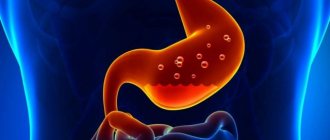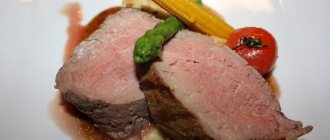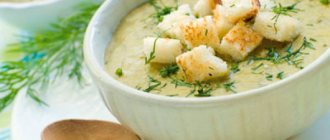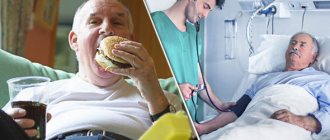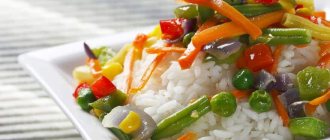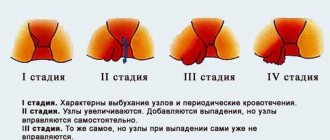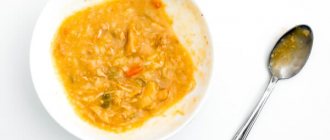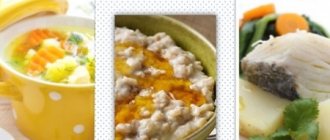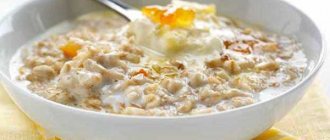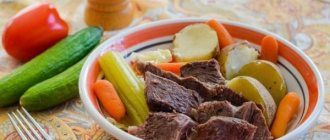Gastritis is an inflammation of the mucous tissues of the stomach lining its walls from the inside. Depending on the location of the lesion or lesions, several subtypes of the disease are distinguished - antral, superficial, atrophic, etc. Erosive - characterized by the formation of erosions and ulcers on the walls of the stomach, and can occur against the background of any of the other forms of inflammation. It poses a threat to the patient's life if treatment is not started in time. Due to the high risk of internal bleeding, the pathology is dangerous for the development of hemorrhagic gastritis.
Following a diet for erosive gastritis is the most important point in complex treatment; the slightest disruption will lead to serious complications
In the acute stage, drug therapy and electrocoagulation are used. Then you can get by with therapeutic nutrition and folk remedies. The symptoms and treatment of erosive gastritis are described in more detail in another article. The diet for erosive gastritis must be followed constantly, otherwise serious complications cannot be avoided.
For information: Proper nutrition during gastric erosion allows you to quickly transfer the acute form of the disease into remission and stop taking medications. But the treatment is not over - it will continue for many months, and you will have to follow the diet for the rest of your life.
General recommendations
In the treatment of erosive gastritis, diet plays a special role. General dietary recommendations to follow:
- Fractional meals: up to 6 times a day;
- Food can be baked, boiled, stewed and steamed;
- Completely exclude various flavor enhancers from the menu, for example, sauces;
- The serving size should be small (about 150 g);
- Before each meal you need to drink one glass of clean water;
- It is strictly forbidden to consume water and food in large quantities. Stretching of the stomach leads to injury to healing ulcers. The usual volume should be reduced by half, or even better by three;
- Liquids and food entering the patient's body must be warm. Taking too cold/hot water and food has a negative effect on the healing of ulcers;
- Eating should be done slowly, chewing each piece thoroughly;
- The last meal should be no later than 2 hours before going to bed.
Causes
The causes of this type of gastritis are various factors:
- Smoking and alcohol abuse.
- Violation of the rules of healthy eating, the presence of spicy and hot foods in the diet.
- Use of certain medications (some anti-inflammatory and painkillers).
- Chronic stress.
- Other diseases of internal organs or the presence of certain infections or bacteria (for example, the bacterium Helicobacter pylori).
- Poisoning with chemical liquids.
- Diabetes.
Treatment with diet
No treatment for diseases of the gastrointestinal tract can be successful without following a special diet. With the help of a diet, the load on the stomach is eased, which greatly facilitates the treatment process.
If you exclude all prohibited foods from your diet, the healing of wounds on the walls of the stomach will be much faster and more effective.
Authorized Products
A person should definitely ask the honey. employee, what can be consumed for erosive gastritis, and what products are prohibited for consumption. Despite all the prohibitions and rules, patients have a fairly extensive list of permitted dishes and ingredients; they just need to prepare them correctly and serve them.
List of dishes that are allowed for consumption:
- Egg omelet, which consists of protein and milk;
- Crackers and baked goods made only from fresh bread;
- Cereal soups, cooking with milk is allowed
- Liquid oatmeal;
- Liquid soups prepared with a weak broth;
- Chicken or turkey meat, cooked in the form of puree;
- Low-fat meatballs or fish cutlets;
- Kissels made from berries and vegetables;
- Tea, you can drink it only if it is not very sweet and not strong.
Prohibited Products
As a rule, when describing a diet, a doctor must note which foods should never be consumed. The following foods should definitely be excluded from the diet:
- Sour fruits;
- Fatty meats or fish;
- Garlic, onions and any dressings for them;
- Fresh bakery;
- Fatty varieties of dairy products;
- Seafood;
- Canned products;
- Smoked meats;
- Alcoholic drinks;
- Strong coffee or tea;
- Any carbonated drinks;
- Fatty soups: for example, rich broths, borscht, mushroom soup;
- Any marinades;
- Yeast dough;
- Millet, pearl barley, corn, barley cereals;
- Any types of sausages;
- Many varieties of cabbage, turnips, mushrooms, radishes.
Acute hemorrhagic lesion
Food poisoning can cause this disease.
When the disease first appears, the symptoms of inflammation are more pronounced, and the disease develops quickly. In this case, an acute form of hemorrhagic gastritis is diagnosed. The peculiarity of this pathology is the low risk of developing gastric bleeding. Provoking factors:
- food poisoning from spoiled or low-quality products, food with a high content of toxic substances;
- poisoning with industrial chemicals, poisons, salts of heavy metals;
- poisoning with strong or low-quality alcohol;
- the presence of connective tissue pathologies;
- severe intoxications causing microcirculatory disturbances in the blood vessels of the organ;
- closed injury with stomach contusion;
- damage to the mucosa when using instrumental diagnostic methods.
The form is characterized by a rapid onset. The pathology has no connection with secretory dysfunction. General symptoms of the disease:
- constant discomfort in the upper abdomen, especially after eating heavy food;
- losing weight while refusing to eat due to association with pain;
- nausea with periodic vomiting;
- heartburn with increased acidity;
- bloating, heaviness, belching with periodic regurgitation against the background of dyspeptic gastric disorders;
- the presence of blood in feces and vomit.
Features of diet for various forms of the disease
The diet for erosive gastritis is the most strict, because... it is necessary to remove all irritating factors, as well as reduce the production of gastric juice. That is why it is not at all surprising that for different forms of the disease a certain diet is prescribed.
Acute form
In the acute course of the disease, a person is assigned to table No. 1. In this case, a person should under no circumstances allow breakdowns. What can you eat if a person is put on this diet?
When a person gets sick, any food provokes pain, so in the first few days it is better to completely avoid eating any food.
After this, boiled eggs and porridge in liquid form are introduced into the food. This is how you need to eat for 21 days. After this, the person can expand the menu a little (to include permitted products).
All food is taken in the form of liquid puree. This can be meat and vegetable purees, soups and jelly. This diet should be followed for about three months.
Chronic form
The chronic form of gastritis requires adherence to one type of diet, because the menu directly depends on the stage: remission or exacerbation. For the first type, table No. 5 is assigned; for the second, table No. 1 is assigned, respectively.
To improve the functioning of the body, the patient should drink a glass of drinking water in the morning. During the remission stage, it is allowed to consume all permitted products, but only in crushed form (they must be without the addition of preservatives and seasonings). In addition, any sweet dishes are also excluded from the menu. Only after 90 days can you include sweets (marshmallows or marshmallows) in your diet.
Reflux gastritis
To reduce the negative effects of acids on the gastric mucosa, the patient is prescribed a gentle diet, in which he will have to give up such dishes as:
Acute;
- Fried;
- Fat;
- Salty;
- Spicy;
- Canned.
In addition, any foods that can injure the gastric mucosa are also excluded from the diet.
Also, dishes that can provoke the occurrence of dumping syndrome should be excluded from the diet. These include sugar, honey, milk porridge (sweet), jam. A person will have to completely give up smoking and alcohol.
Antral-erosive form
If a person has been diagnosed with erosive-antral gastritis, the diet is practically no different from other types of this disease.
The main thing to remember is that any food should be chopped, and even better, consume slimy soups. You can also eat fresh cottage cheese and oatmeal.
Video on the topic: Diet for erosive gastritis of the stomach.
Signs and symptoms
The manifestations of hemorrhagic gastropathy are nonspecific, so it is often confused with other types of pathology and gastrointestinal ulcers. Symptoms may appear all at once, or they may develop gradually:
- Complaints. The man points:
- for epigastric pain, especially after eating;
- the appearance of gastric disorders, characterized by heartburn, belching, heaviness, nausea, loss of appetite;
- symptoms of gastric bleeding: tarry vomiting, dizziness, black feces.
- On examination, the following symptoms are visualized:
- pale skin;
- thick coating on the root of the tongue;
- pain in the stomach upon palpation;
- cold extremities;
- drop in blood pressure and increased heart rate with heavy bleeding.
- Diagnosis reveals:
- single hemorrhage or multiple clusters that bleed on blood-soaked mucosa;
- high or normal acidity;
- negative test for Helicobacter;
- anemic signs in the blood test.
Menu for gastritis
Let's consider a sample menu for a week that can be compiled for a patient with gastritis.
Monday:
- For breakfast, you can cook an omelet with milk.
- For lunch, noodle soup and baked apples with cottage cheese.
- For an afternoon snack, you can prepare cottage cheese casserole with pumpkin (prepared in a slow cooker).
- For dinner, you can cook fish meatballs with mashed potatoes.
Tuesday:
- For breakfast, you can prepare oatmeal with raisins and apples (raisins should be added according to tolerance and the patient’s condition).
- Lunch may consist of chicken soup and baked apples;
- For an afternoon snack, prepare a fruit cocktail using kefir with the addition of cottage cheese (canned fruits should be replaced with fresh ones).
- Dinner consists of fish balls and mashed potatoes.
Wednesday:
- For breakfast you can eat buckwheat porridge cooked with milk (prepared in a slow cooker).
- Lunch: Soup made from hake (vegetables should never be fried), risotto with pumpkin and baked veal.
- The afternoon snack consists of zucchini stewed in sour cream.
- For dinner, you can make carrot and zucchini casserole and steamed chicken cutlets.
Thursday:
- Breakfast: poached egg.
- Hake soup and baked veal (lunch).
- For an afternoon snack, you can eat baked peaches and nuts.
- Dinner: carrot and zucchini casserole and chicken cutlets.
Friday:
- Breakfast: millet porridge with pumpkin.
- Lunch: kulesh and salmon sausages.
- Kissel, which is prepared from frozen cranberries and cherries.
- Dinner: buckwheat with minced meat.
Saturday:
- Any porridge with milk (breakfast).
- For lunch you can cook kulesh and salmon sausages.
- For an afternoon snack, you can make yourself jelly from gelatin.
- Dinner: Greek bread with minced meat.
Sunday:
- For breakfast, you can make a casserole of buckwheat and cottage cheese.
- Salmon fish soup and potato casserole are served for lunch.
- For an afternoon snack, you can make jelly from gelatin.
- For dinner you can eat soufflé with carrots and rice.
Details about the weekly diet
It is best if the diet for erosive gastritis of the stomach is prescribed for each day by a specialist. Thus, the patient will not be able to eat a prohibited product or exceed the serving size. Let's look at the menu for erosive gastritis of the stomach for a week with recipes.
Monday
- Breakfast: boiled chicken eggs (2 pcs.), a weak tea drink and a few white bread crackers;
- Snack: banana, mashed;
- Lunch: pureed celery soup, boiled chicken meatballs, rosehip broth and a few crackers;
- Snack: berry mousse;
- Dinner: boiled potatoes and fish fillet;
- 2 hours before bedtime: a glass of low-fat kefir.
Tuesday
- Breakfast: thin oatmeal with honey, chamomile tea;
- Snack: jelly and biscuits;
- Lunch: liquid soup of potatoes and cereals without frying, fish cutlet and fruit drink;
- Snack: fruit soufflé;
- Dinner: meat stew in the form of puree;
- 2 hours before bed: yogurt.
Wednesday
- Breakfast: rice pudding, compote;
- Snack: sweet apple;
- Lunch: beetroot soup, boiled potatoes with chicken cutlets, weak tea drink;
- Snack: biscuits;
- Dinner: boiled vegetables in the form of puree and boiled fish, a decoction of herbs and crackers;
- 2 hours before bedtime: weak tea with milk.
Thursday
- Breakfast: cottage cheese cutlets, weak tea;
- Snack: watermelon;
- Lunch: vegetable soup and chicken soufflé, croutons and compote;
- Snack: sweet pear;
- Dinner: thin rice porridge and chicken liver soufflé, herbal decoction;
- 2 hours before bedtime: warm skim milk.
Friday
- Breakfast: omelet with milk and two egg whites, berry jelly;
- Snack: baked apple;
- Lunch: kharcho soup without frying, baked and chopped chicken fillet, boiled potatoes, compote;
- Snack: dried apricots 100 g;
- Dinner: buckwheat with vegetables, crackers and weak chamomile tea;
- 2 hours before bedtime: fermented baked milk.
Saturday
- Breakfast: casserole of berries and cottage cheese, tea;
- Snack: yogurt;
- Lunch: vegetarian vegetable soup, rabbit cutlet, boiled rice, compote;
- Snack: cottage cheese;
- Dinner: boiled vegetables and fish, herbal decoction;
- 2 hours before bedtime: kefir.
Sunday
- Breakfast: lazy dumplings with low-fat yogurt, compote;
- Snack: dried apricots 100 g;
- Lunch: cereal soup, boiled fish and tea with crackers;
- Snack: berry soufflé;
- Dinner: minced rabbit pilaf, tea with milk;
- 2 hours before bed: yogurt.
By adhering to such a strict therapeutic diet, you can significantly improve your condition and achieve sustainable remission. Breakdowns and overeating should not be allowed. You should carefully monitor the consistency and temperature of the dish.
Dish recipes
Frozen fruit jelly. Put washed cherries (about 300 g) and cranberries (200 g), add 6-7 tbsp. sugar and add water (liter). Cook for two hours. At this time, dilute the starch in water and gradually add to the jelly. In a few minutes the jelly is ready.
- Salmon soup. The tail must be washed and placed in a pan and filled with water. Bring to a boil, skim off the foam and add a peeled onion and a few bay leaves to the broth. Salmon does not take long to cook. While the broth is cooking, peel the potatoes and cut them into large cubes. Carrots also need to be cut into thick slices. Place the tail, discard the onion and bay leaves. Add prepared vegetables, salmon steak and a few peppercorns to the boiling broth and cook until tender, about 20 minutes. The dish is ready and can be served.
